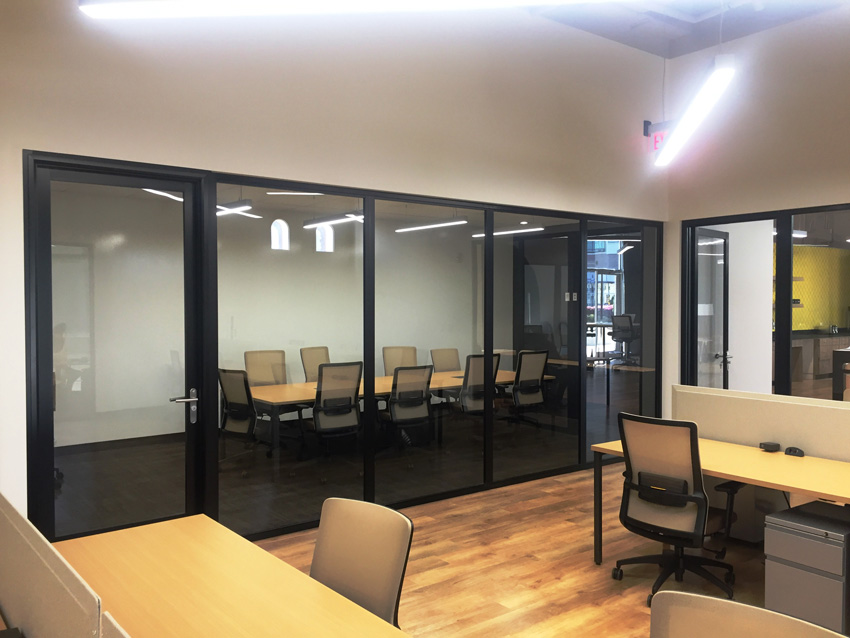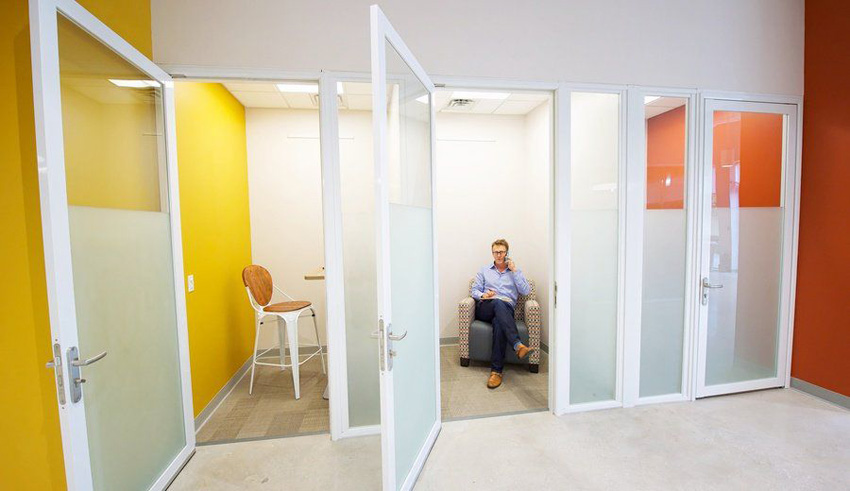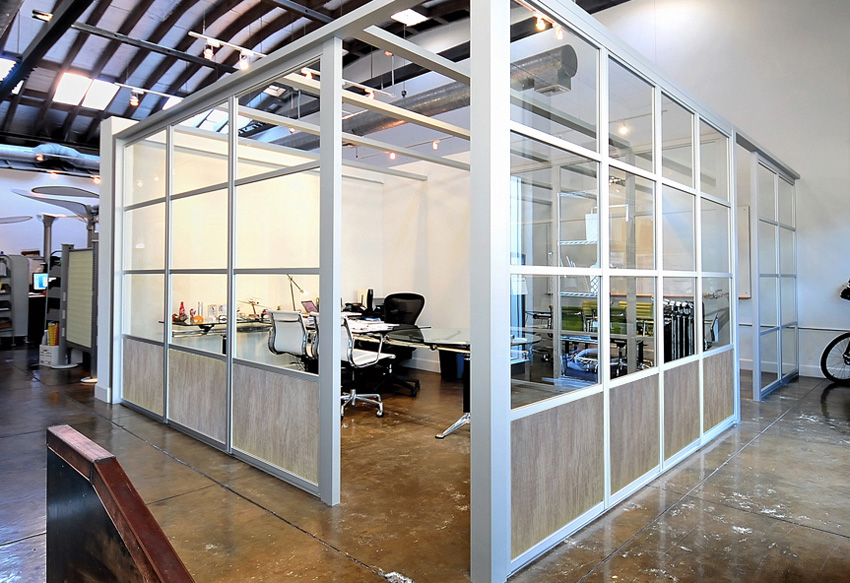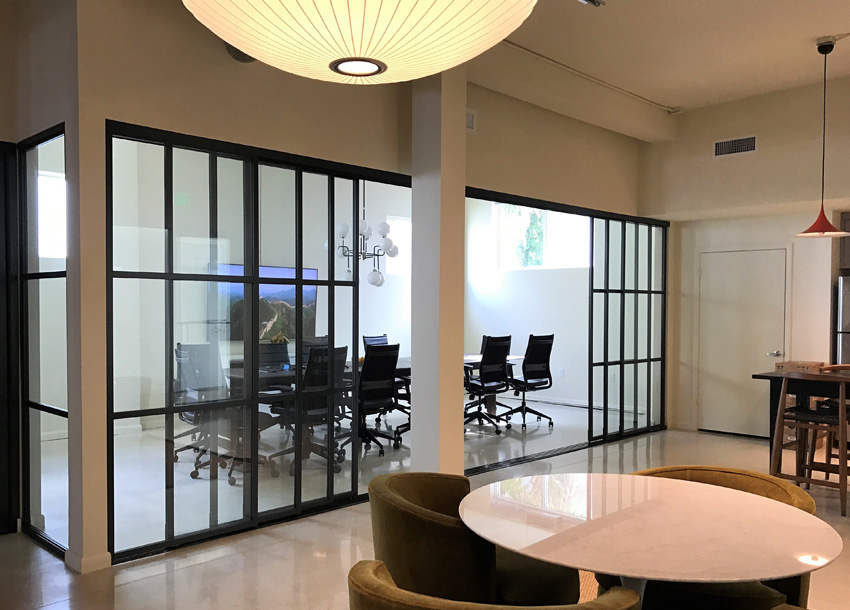Maximizing Value with Interior Glass Door Solutions
Glass Dividers
In order to create these much-needed spaces, designers are turning to systems like glass walls, partitions, and phone booths. A relatively easy way to strategically place enclosed areas throughout the floor plate, these types of designs also work to preserve the daylighting and flow of the space.

Sliding glass partitions enable workers to open or close the doors based upon the task at hand.

As part of a mix of open and enclosed areas, employees have access to small phone booths for private phone conversations or quiet, focused work.
Take CetraRuddy’s recent design for the offices of a large New York real estate broker. In addition to open benching systems and areas for collaborative work, privacy-enhancing features include a meditation room, private break spaces, lounge-like telephone booths, and a custom glass-tile screen. Glass walls were utilized for all the conference spaces and private offices, which allows sunlight and transparency to penetrate through the entire office space.
Peggy Bennett, IIDA, CIDQ, LEED AP, associate vice president, director of commercial interiors, Hoefer Wysocki, Kansas City, Kansas, suggests that by strategically breaking up floor plates and positioning them in such a way to allow natural light, the space can feel more like a home.
“Introducing natural daylight into interior spaces is not only essential to wellness, but it is also a critical component of creating an effective workplace,” adds Lynn Brotman, NCIDQ, IIDA, associate principal, Svigals + Partners, New Haven, Connecticut. “Glass, even if partially frosted for privacy, allows the light to penetrate deep into the space, fostering a feeling of connection and appreciation for the biophilic value of natural light.”
Practically speaking, a common strategy is bringing the private offices inboard, which frees up the perimeter for workstations, collaborative hubs, and work cafes. In providing separation for these two zones, Donna Leventhal, architect, DL Design Architects, Los Angeles, frequently specifies glass doors to meet end users’ privacy, acoustic, and daylighting needs.
Oftentimes, architects like to get creative with glass systems. A good example is CetraRuddy’s design for its own New York studio. In this case, a magnetic, writable glass partition wall separates a large collaborative area and pantry from the open benching systems, relates Principal and Director of Interior Design Ximena Rodriguez. The wall divides the spaces while promoting daylighting, preserving a feeling of openness, and enhancing the architectural firm’s workflow and collaboration. During the office’s monthly UnCrit, which is a show-and-tell for project teams, the wall serves as a canvas to pin up project images.
For CetraRuddy’s conference rooms, the architects decided to position them deep into the building core. “Specifying glass walls for these rooms was critical in making them feel light, airy, and comfortable,” explains Rodriguez.
For these glass systems, gradient film was selected to create a feeling of privacy from shoulder-height down to the floor. The film is clear on the top and becomes translucent as it descends, which brings light into the conference rooms and creates a sense of cohesiveness without giving too much exposure to people engaged in a private conference. “We have used this gradient approach in other commercial office projects as well, and also in amenity spaces for multifamily properties,” Rodriguez adds.
As another example, Krueck Sexton Partners takes an interesting approach with its larger governmental and institutional clients with large floor plates.
“We think of interior projects as urban environments with neighborhoods, cross streets, and town squares, and we create a hierarchy of zones. The first zone involves the exterior and lobby experience. Next are the streets or walkways along the core and then spaces along the window line,” explains Don Semple, AIA, an associate principal with the Chicago-based Krueck Sexton Partners. “Pulling offices and workstations off the window line and incorporating transparent materials ensures greater access to daylight, and placing these environments within easy sightlines further defines the space.”
Christiansen also points out that glass office fronts lend a more modern design aesthetic. “These days, most of our clients expect glass offices rather than thinking about glazing as an extra or unnecessary cost,” she relates.
Reconfigurations
The reality of office spaces is that they are reconfigured rather frequently. Additionally, JLL reports that the average office fit out grew by 12 percent in 2018. Naturally, many organizations struggle with tight budgets and are looking for ways to postpone or avoid a full fit out, if possible.
Along these lines, demountable walls are a go-to strategy. As opposed to the dust-inducing, more labor-intensive process of drywall construction, glass enclosures can be installed or reconfigured in a short time.

Demountable glass partitions can be reconfigured to meet changing needs.
“Demountable walls can be a very flexible and sustainable solution for tenants because they do not require tear down and building new wall systems like traditional stick construction. It is faster and better for the environment,” states Leigh Stringer, LEED AP, managing principal, EYP Architecture & Engineering, Washington, D.C. “Flexible solutions can help make an office environment work for the occupants longer.”
Additionally, commercial leasing companies seeking to fill open vacancies can offer “configure the space as your business requires” as part of the enticement to sign a lease. In such a case, tenant improvement funds will cover the cost of changes and configurations.
These types of design solutions are also more environmentally friendly because they can be moved and repurposed, as opposed to demolition and rebuilding, which is the case with metal studs and drywall. Even within the same space, sliding, stacking, reconfigurable glass panels allow for optimum usage of the room. For example, a conference room can be easily opened up for a larger company meeting by sliding the doors completely into pockets hidden within the wall or provide full clearance by stacking against the wall.
“The opportunity to integrate glazing gives many of these systems a more refined look than drywall partitions and paint,” adds LGA’s Glance. “They impact construction schedules favorably, and clients love the tax benefits of being able to depreciate them just like furniture.”
Standard construction reconfiguration is messy and time consuming, relates Carl Haines, senior project manager, Johnson & Jennings General Contracting, San Diego, in a Building Operating Management article titled “Demountable Walls: Moving On Up.” Unlike regular construction, which can take several weeks, a demountable wall reconfiguration can typically be taken care of over the weekend, without standard construction issues like drying time, dust from debris, or fumes.
From an economic perspective, a typical budget to reconfigure an office space runs at least $15,000 per individual office. With demountable wall construction, the cost can be reduced by as much as 60 percent.
Furthermore, easily configurable spaces help control costs because they can accommodate ongoing changes in building occupancy needs. For example, meeting rooms that can quickly transform into open offices or smaller quiet zones with a framing system that can be changed without interrupting everyday business activities is ideal. However, if a system is too hard to adjust, in Semple’s experience, the organization will not take full advantage of this flexibility.
Offering some overall perspective, Seth Hanley, AIA, LEED AP, co-founder and principal of the architecture and interior design firm Blitz, Culver City, California, states that reconfiguration provides an interesting final layer to a project, allowing for its calibration and evolution over time. However, when professionals with special training are required for reconfiguration, the use of that element tends to decline.
Additionally, the ability to cost-effectively and aesthetically break up floor plates to create additional rooms and privacy can improve the lease-ability of a space. “In buildings where demountable systems are included as part of a lease package, or where a tenant is subleasing a space, existing movable systems enable occupants to move walls and change quickly, which is a plus,” Semple adds.
Consequently, if a space is built out with demountable glass partitions and enclosures, building owners can more easily cater to prospective tenant needs by configuring the layout to fit their needs in a cost-effective and time-efficient manner.
“The benefit here is the flexibility it offers for a variety of different types of tenants to occupy it, as they can put it together and reconfigure it at a moment’s notice,” confirms SquareFoot’s Wasserstrum.
Incidentally, Ron Lustig, AIA, ISHC, EDAC, LEED Green Associate, principal, Earl Swensson Associates, Nashville, adds that abundant glass, more expansive glass walls, and higher floor-to-ceiling heights help to make office spaces more attractive to lease.

Sliding glass doors create a striking aesthetic and promote daylighting.
Breaking Out of the Square
Some newer advances in glass wall technology are enabling designers and owners to more fully utilize their interior spaces.
For example, a newly engineered mold can create glass partitions in non-90-degree angled spaces, both acute and obtuse. Since the post can be swiveled to any degree, the challenge of dealing with columns jutting out and other structural limitations is very much minimized. Instead, architects can fully utilize what would otherwise be considered dead space.
“On our renovation projects, we often encounter existing conditions with unusual geometries. Such a flexible system can allow for easier integration into these environments,” says Semple.
While Leventhal appreciates the application for floor plates without 90-degree corners, she is more interested in leveraging the angled walls to create more aesthetic designs. Similarly, Glance sees the technology as an opportunity for different angles to be used to add dramatic flair to feature walls or entrances.
Responding to this new possibility of angled enclosed glass designs, Leslie Saul, AIA, NCIDQ, LEED AP BD+C, who runs her architecture and interiors firm in Cambridge, Massachusetts, exclaims, “Fantastic! Get people out of the box and create diagonal-view corridors.”
In a similar vein, Stantec’s James poetically relates, “As interior designers, we love when we get the square buildings with minimal core footprint and perfectly spaced column grid. It makes our jobs a cinch. But as architects, we love anything but a square building.”
Essentially, architects agree that any opportunity to expand beyond the typical 90-degree wall configuration is beneficial when developing a design that is specific for a particular client and in differentiating the space. In seeking to expand beyond the usual office configuration, atypical environments can provide an interesting design aesthetic.
Bringing in another viewpoint, Melissa Hanley, AIA, IIDA, LEED AP, Blitz co-founder, principal, and CEO, suggests a design that uses reflection from angled glazing could extend the perception of space and also function as an acoustic strategy, using nonparallel surfaces to reduce sounds reflections. “Ideally, such a system could maintain the utility of a more traditional interior products and become a unifying element throughout a project.”
Practically speaking, the non-90-degree-angle system that offers flexibility to plan for glass partitions in angles would allow designers to capitalize on otherwise difficult-to-plan-in spaces.
“Ultimately, non-90-degree-angle glass solutions offer a lot of options for increasing flexibility, which is always a prime consideration in commercial facilities,” Rodriguez says.
Bringing in a manufacturer’s perspective, Sheryl Hai-Ami, administration officer, The Sliding Door Company, Chatsworth, California, says, “Being able to solve tough space-planning challenges by providing solutions that meet our clients’ project requirements is why we love what we do.”
In a nutshell, having a better “kit of parts” with more configuration options lends itself to more creative and functional solutions.









